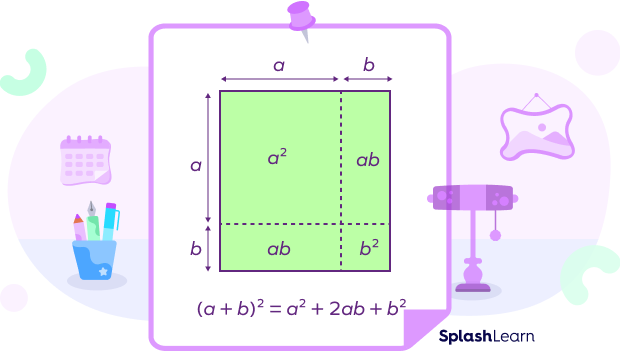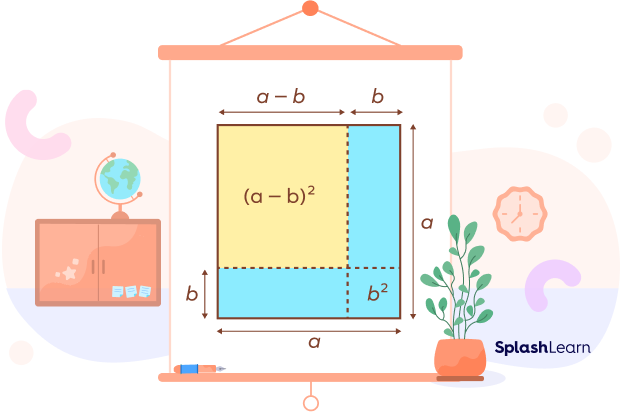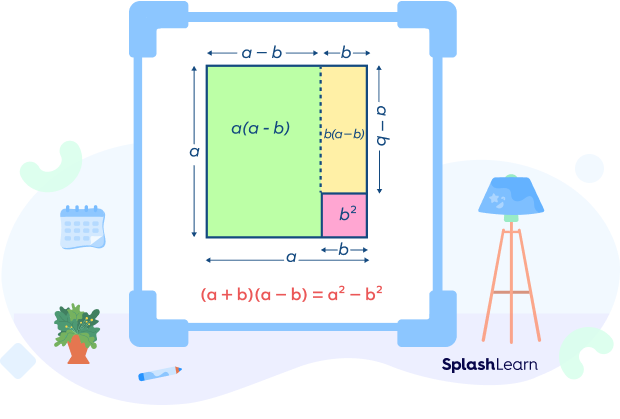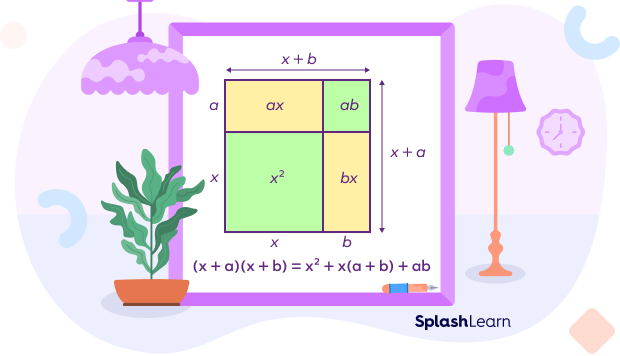What Are Algebraic Identities?
An algebraic identity is basically an equation in which L.H.S. equals R.H.S. for all values of the variables. An identity in math is an equation that holds true for all the values, even if you change the variables involved. For every value of the variables, an algebraic identity indicates that the left and right sides of the equation are identical.
Algebraic identities are equations that hold true for all values of variables.
In mathematical identities, the values on the left and right sides of the equation are exactly the same. We use algebraic identities as a set of formulas that help us in simplifying and solving algebraic equations.
Consider an example.
To expand the algebraic expression $(x + 1)^2$, you will have to multiply $(x + 1)$ with itself. It will surely be lengthy and time consuming.
However, if you use the algebraic identity $(a + b)^2 = a^2 + 2ab + b^2$, you will simply have to substitute the values and your job is done!
Recommended Games
Algebraic Identity Definition
An important set of mathematical formulas or equations where the value of the L.H.S. of the equation is equal to the value of the R.H.S. of the equation.
Algebraic identities simplify algebraic expressions and calculations.
Here are examples of common algebraic identities:
- $(a + b)^2 = a^2 + 2ab + b^2$
- $(a \;−\; b)^2 = a^2 \;−\; 2ab + b^2$
- $a^2 \;−\; b^2 = (a + b)(a \;−\; b)$
- $(x + a)(x + b) = x^2 + x(a + b) + ab$
Algebraic Identities with Two Variables
The algebraic identities with two variables are known as two variable identities. Some basic two-variable algebraic identities are as follows:
- $(a + b)^2 = a^2 + 2ab + b^2$
- $(a \;−\; b)^2 = a^2 \;−\; 2ab + b^2$
- $a^2 \;−\; b^2 = (a + b)(a \;−\; b)$
- $(a + b)^3 = a^3 + 3a^2 b + 3ab^2 + b^3$
- $(a \;− \;b)^3 = a^3 \;−\; 3a^2b + 3ab^2 \;−\; b^3$
Algebraic Identities with Three Variables
Some of the most important algebraic identities that use three variables are as follows:
- $(a + b + c)^2 = a^2 + b^2 + c^2 + 2ab + 2bc + 2ac$
- $a^3 + b^3 + c^3 \;−\; 3abc = (a + b + c)(a^2 + b^2 + c^2 \;−\; ab \;−\; ca \;−\; bc)$
Two identities can be derived from the above two identities.
- $a^2 + b^2 + c^2 = (a + b + c)^2 \;−\; 2(ab + bc + ac)$
- $(a + b)(b + c)(c + a) = (a + b + c)(ab + ac + bc) − 2abc$
How to Prove Algebra Identities
Algebraic identities can be proved by verifying if the L.H.S. (left-hand side) is equal to R.H.S. (right-hand side). Here, you have to solve and simplify the expression on one side (or both sides) using simple arithmetic operations.
Proof of Algebra Identities
Let’s look at the proof of some fundamental algebraic identities.
Proof of (a + b)2 = a2 + 2ab + b2
This formula is used to find the square of a binomial involving addition.
L.H.S. $= (a + b)^2$
L.H.S. $= (a + b) \times (a + b)$
L.H.S. $= a^2 + ab + ba + b^2$
L.H.S. $= a^2 + 2ab + b^2$
L.H.S. $=$ R.H.S.
Hence proved.

Proof of (a − b)2 = a2 − 2ab + b2
This identity helps to expand the square of the difference between the two variables.
L.H.S. $= (a \;−\; b)^2$
L.H.S. $= (a \;−\; b) \times (a \;−\; b)$
L.H.S. $= a^2 \;−\; ab \;−\; ba + b^2$
L.H.S. $= a^2 \;−\; 2ab + b^2$
L.H.S. $=$ R.H.S.
Hence proved.

Proof of (a + b)(a – b) = a2 – b2
This identity helps to find the difference between two squares without actually calculating the individual square numbers.
L.H.S. $= (a + b)(a \;−\; b)$
L.H.S. $= a^2 \;−\; ab + ba \;−\; b^2$
L.H.S. $= a^2 \;− \;b^2$
L.H.S. $=$ R.H.S.
Hence proved.

Proof of (x + a)(x + b) = x2 + x(a + b) + ab
L.H.S. $= (x + a)(x + b)$
L.H.S. $= x^2 + bx + ax + ab$
L.H.S. $= x^2 + x(a + b) + ab$
L.H.S. $=$ R.H.S.
Hence proved.

List of Standard Algebraic Identities
| Identity 1 | $(a + b)^2 = a^2 + 2ab + b^2$ |
| Identity 2 | $(a \;–\; b)^2 = a^2 – 2ab + b^2$ |
| Identity 3 | $a^2 \;–\; b^2 = (a + b)(a \;–\; b)$ |
| Identity 4 | $(x + a)(x + b) = x^2 + (a + b)x + ab$ |
| Identity 5 | $(a + b)^3 = a^3 + b^3 + 3ab (a + b)$ |
| Identity 6 | $(a \;–\; b)^3 = a^3 \;–\; b^3 \;–\; 3ab (a \;–\; b)$ |
| Identity 7 | $(a + b + c)^2 = a^2 + b^2 + c^2 + 2ab + 2bc + 2ca$ |
| Identity 8 | $a^3 + b^3 + c^3\;–\; 3abc = (a + b + c)(a^2 + b^2 + c^2 \;–\; ab \;–\; bc \;–\; ca)$ |
Factorization Identities List
Some of the higher algebraic expressions, like $a^4 \;–\; b^4,\; a^6 \;–\; b^6,\; a^6 + b^6$, etc., can be easily factorized with a collection of algebraic identities that can be used to factor polynomials. The following are some common factorization identities.
| Factorization Identities |
|---|
| $a^2 \;–\; b^2 = (a + b)(a \;–\; b)$ |
| $(x + a)(x + b) = x^2 + (a + b)x + ab$ |
| $a^3 \;–\; b^3 = (a \;–\; b)(a^2 + ab + b^2)$ |
| $a^3 + b^3 = (a + b)(a^2 \;–\; ab + b^2)$ |
Facts about Algebraic Identities
An algebraic identity in terms of “a” and “b” holds true for all the values of a and b.
The binomial theorem describes the algebraic expansion of powers of a binomial, $(x + y)^n$. It is also known as the “binomial identity.”
Conclusion
In this article, we have learned about all algebraic identities, proofs, and related facts. Let’s solve a few examples and practice problems based on the list of algebraic identities.
Solved Examples on Algebraic Identities
- Find the value of $195 \times 205$.
Solution:
$195 \times 205$ can be written as $(200 \;–\; 5) \times ( 200 + 5)$
Applying $(a + b)(a \;–\; b) = a^2 \;–\; b^2$ with $a = 200$, and $b = 5$, we get
$(200 \;–\; 5) \times ( 200 + 5) = 200^2 \;-\; 5^2$
$= 40000 \;–\; 25$
$= 39975$
- Using algebraic identities simplify $(5p \;–\; 6q)^2 + (5p + 6q)^2$
Solution:
The given expression is in the form of $(a \;–\; b)^2 + (a + b)^2$
So, we have to apply the following identities
- $(a + b)^2 = a^2 + 2ab + b^2$
- $(a \;–\; b)^2 = a^2 \;–\; 2ab + b^2$
Here, $a = 5p$, and $b = 6q$
$(5p \;–\; 6q)^2 = (5p)^2 \;–\; 2(5p)(6q) + (6q)^2 = 25p^2 \;–\; 60pq + 36q^2$ … (i)
$(5p + 6q)^2 = (5p)^2 + 2(5p)(6q) + (6q)^2 = 25p^2 + 60pq + 36q^2$ … (ii)
Now adding equations (i) and (ii), we get
$(5p \;–\; 6q)^2 + (5p + 6q)^2 = 25p^2 \;–\; 60pq + 36q^2 + 25p^2 + 60pq + 36q^2$
$= 2(25p^2 + 36q^2)$
$\therefore (5p \;–\; 6q)^2 + (5p + 6q)^2 = 2(25p^2 + 36q^2)$
- Using standard algebraic identities, determine the product of $(2k + 4)$ and $(2k + 9)$.
Solution:
Given multiplication is $(2k + 4) \times (2k + 9)$
Apply $(x + a)(x + b) = x^2 + (a + b)x + ab$
Here $x = 2k,\; a = 4,$ and $b = 9$
So, $(2k + 4) × (2k + 9) = (2k)^2 + (4 + 9)2k + (4)(9)$
$= 4k^2 + 26k + 36$
- Using standard identities simplify $(2x \;–\; y)^3 + ( 2x + y )^3$
Solution:
The given expression is in the form of $(a \;–\; b)^3 + (a + b)^3$
So, we have to apply the following identities
- $(a + b)^3 = a^3 + b^3 + 3ab (a + b)$
- $(a \;–\; b)^3 = a^3 \;–\; b^3 \;–\; 3ab (a \;–\; b)$
Here, $a = 2x$, and $b = y$
$(2x \;–\; y)^3 = (2x)^3 \;–\; y^3 \;–\; 3(2x)(y) (2x \;–\; y) = 8x^3 \;–\; y^3 \;–\; 6x^2 y + 6xy^2$ … (i)
$(2x + y)^3 = (2x)^3 + y^3 + 3(2x)(y) (2x + y) = 8x^3 + y^3 + 6x^2y + 6xy^2$ … (i)
Adding equations (i) and (ii), we get
$(2x \;–\; y)^3 + (2x + y)^3 = 8x^3 \;–\; y^3 \;–\; 6x^2 y + 6xy^2 + 8x^3 + y^3 + 6x^2 y + 6xy^2$
$= 2(8x^3 + 6xy^2) = 4(4x^3 + 3xy^2)$
$\therefore (2x \;–\; y)^3 + (2x + y)^3 = 4(4x^3 + 3xy^2)$
- Using factorization identities, factorize $(8x^3 + 27y^3)$.
Solution:
The given expression can be written as $(8x^3 + 27y^3) = (2x)^3 + (3y)^3$,
which is in the form of $a^3 + b^3$
So, for factorization we have to apply the identities $a^3 + b^3 = (a + b)(a^2 \;–\; ab + b^2)$
Here, $a = 2x$ and $b = 3y$
Now
$(8x^3 + 27y^3) = (2x)^3 + (3y)^3$
$= (2x + 3y)((2x)^2 \;–\; (2x)(3y) + (3y)^2)$
$= (2x + 3y)(4x^2 \;–\; 6xy + 9y^2)$
Hence, $(8x^3 + 27y^3) = (2x + 3y)(4x^2 \;–\; 6xy + 9y^2)$
Practice Problems on Algebraic Identities
Algebraic Identities: Definition, Factorization, Proof, Examples, FAQs
Which of the following expressions is equal to $(2x + 3)^2$?
We know that $(a + b)^{2} = a^{2} + 2ab + b^{2}$
$(2x + 3)^{2} = (2x)^{2} + 2(2x)(3) + 3^{2} = 4x^{2} + 12x + 9$.
Which of the following is equal to $(x\;−\;7)(x + 7)$?
We know that $(a + b)(a\;–\;b) = a^2\;–\;b^2$.
$(x\;−\;7)(x + 7) = x^2\;−\;49$.
Which of the following is equal to $x^3\;−\;y^3$?
We know that $a^3\;–\;b^3 = (a\;–\;b)(a^2 + ab + b^2)$
$x^3\;−\;y^3 = (x\;–\;y)(x^2 + xy + y^2)$.
Which of the following is an identity?
We observe that $x(x + 1) = x^2 + x$ that is L.H.S $=$ R.H.S.
Hence, it is an identity.
Frequently Asked Questions on Algebraic Identities
What are the three variable identities?
The identities in algebra with three variables are known as three-variable identities. Some basic three-variable algebraic identities are as follows:
(i) (a + b + c)2 = a2 + b2 + c2 + 2ab + 2bc + 2ac
(ii) a3 + b3 + c3 − 3abc = (a + b + c)(a2 + b2 + c2 − ab − ca − bc)
What are the factorization identities?
Some common factorization identities are
a2 – b2 = (a + b)(a – b), (x + a)(x + b) = x2 + (a + b)x + ab
a3 – b3 = (a – b)(a2 + ab + b2)a3 + b3 = (a + b)(a2 – ab + b2), etc.
How many basic algebraic identities can be found in math?
There are four basic algebraic identities in math:
- (a + b)2 = a2 + 2ab + b2
- (a – b)2 = a2 – 2ab + b2
- a2 – b2 = (a + b)(a – b)
- (x + a)(x + b) = x2 + (a + b)x + ab
What is the difference between identities and expressions in algebra?
An algebraic identity is an equation. It holds true for all the values of the variable.
Algebraic identity: 7y + 2 = 16
An algebraic expression is formed using terms involving variables and constants; there is no equal sign.
Algebraic expression: 7y + 2
What is the use of algebraic identities?
The use of algebraic identities simplifies mathematics calculations. When it comes to resolving quadratic and higher-power equations, algebraic identities play a crucial role. Also, products of numbers and other quantities can be calculated using algebraic identities.
What is the algebraic identity for finding the sum of squares of two numbers?
a2+b2= (a+b)2-2ab
What are the 13 algebraic identities?
- (a + b)2= a2 + 2ab + b2
- (a – b)2 = a2 – 2ab + b2
- a2 – b2 = (a + b)(a – b)
- a3 – b3 = (a – b)(a2 + ab + b2)
- a3 + b3 = (a + b)(a2 – ab + b2)
- (a + b + c)2 = a2 + b2 + c2 + 2ab + 2bc + 2ac
- a3 + b3 + c3 − 3abc = (a + b + c)(a2 + b2 + c2 − ab − ca − bc)
- (a − b − c)2 = a2 + b2 + c2 − 2ab + 2bc + 2ac
- (a + b + c)2 = a2 + b2 + c2 + 2ab + 2bc + 2ac
- (a + b – c)2 = a2 + b2 + c2 + 2ab – 2bc – 2ac
- (a – b + c)2 = a2 + b2 + c2 – 2ab – 2bc + 2ac
- (–a + b + c)2 = a2 + b2 + c2 – 2ab + 2bc – 2ac
- (a + b)3 = a3 + 3a2b + 3ab2 + b3
- (a – b)3 = a3 – 3a2b + 3ab2 – b3



















